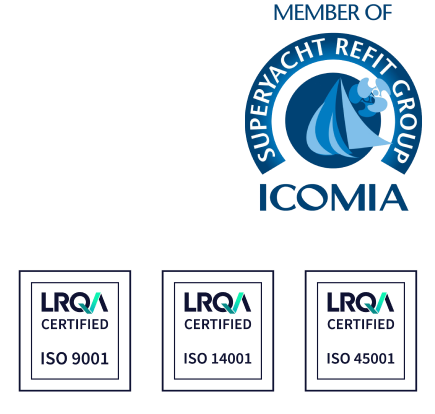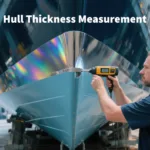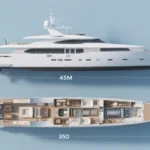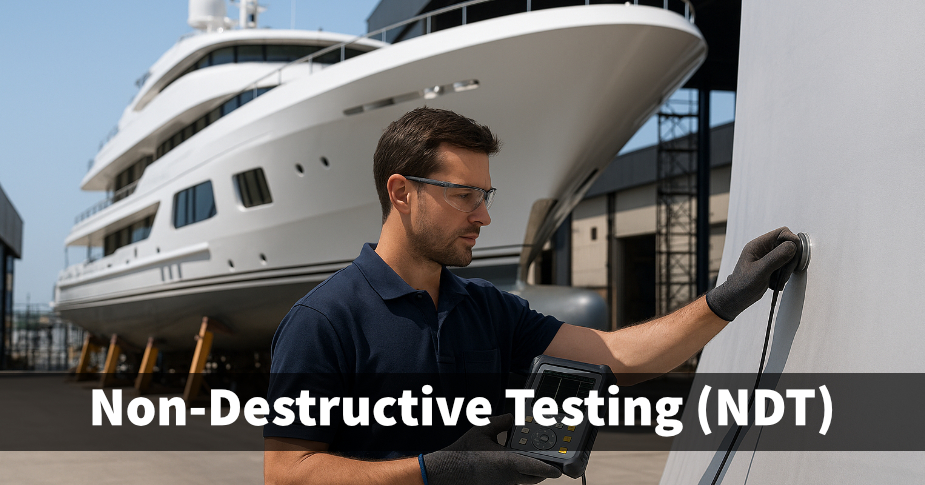Superyachts are complex machines. They’re part floating palace, part technical marvel, and part investment. When something goes wrong, the stakes can be high, both financially and in terms of safety. NDT is one of the quiet heroes of modern maintenance and refit work, allowing professionals to detect issues before they become problems. Whether you’re inspecting a weld, checking the condition of a propeller shaft, or assessing hull integrity, NDT lets you do it without tearing everything apart.
So, What Exactly Is Non-Destructive Testing?
Non-Destructive Testing refers to a group of techniques used to inspect materials or components without causing any damage. It’s the opposite of destructive testing, where a part might be cut, pulled, or stressed until it fails to understand how strong it is. With NDT, the goal is to evaluate the internal or surface condition of a material without compromising its usability.
Think of it as a kind of medical check-up for inanimate objects. Just like doctors use X-rays or ultrasounds to see what’s happening inside the body without surgery, NDT uses tools like ultrasonic waves, magnetic fields, or even simple dyes to look beneath the surface.
Common NDT Techniques (and What They Reveal)
-
Ultrasonic Testing (UT): High-frequency sound waves are sent into the material. By measuring how the waves bounce back, technicians can spot internal cracks, voids, or thickness changes.
-
Dye Penetrant Testing (DPT): A dye is applied to the surface of a metal part. It seeps into cracks, then a developer draws it out, making even fine surface cracks visible.
-
Magnetic Particle Testing (MT): Used mainly on ferromagnetic materials. The part is magnetized, and magnetic particles reveal surface and near-surface flaws.
-
Radiographic Testing (RT): Similar to an X-ray for metal. It can spot internal flaws like porosity in welds or hidden corrosion.
-
Visual Testing (VT): This is exactly what it sounds like—careful visual inspection, sometimes aided by borescopes or cameras in tight spaces.
Each of these methods serves a specific purpose and can be chosen based on what material is being tested, the part’s accessibility, and the type of flaw being investigated.
Not to Be Confused With…
People sometimes mix up Non-Destructive Testing (NDT) with Non-Destructive Evaluation (NDE) or Non-Destructive Inspection (NDI). While they overlap, there’s a subtle difference. NDE often involves interpreting results to understand material properties, while NDI focuses on locating defects. NDT is the broader umbrella term that covers both activities. For practical purposes in the yachting world, though, these terms are often used interchangeably.
Where Is NDT Used in Yachting?
In the yachting industry, especially during refit projects, pre-purchase inspections, and classification surveys, NDT plays a critical role. It’s commonly used to inspect:
-
Welds in steel or aluminum hulls
-
Propeller shafts, rudder stocks, and other drivetrain components
-
Pressure vessels and piping systems
-
Mast fittings and structural elements in sailing yachts
-
Hull thickness and corrosion under coatings
Whether it’s a small job or a full-scale refit, NDT helps yacht workers assess the condition of key parts without dismantling them, saving time, money, and avoiding unnecessary replacements.
How Does It Actually Work?
Most NDT techniques rely on physics principles like wave behavior, magnetism, or chemical interactions. Let’s take ultrasonic testing as an example: a technician places a probe against a surface. That probe sends sound waves into the material. If there’s a flaw, the wave reflects back differently. That feedback gets translated into a digital readout or image, which the technician interprets.
Crucially, all this is done without drilling, cutting, or altering the material in any way. That means the component can go right back into service if it passes inspection.
Why It’s More Than Just “Testing”
One of the biggest advantages of NDT is preventive maintenance. It lets yacht professionals catch corrosion, cracks, or fatigue early, before they lead to equipment failure or safety issues. This is especially important for compliance with classification societies and insurance providers, which often require proof that critical systems have been inspected and deemed safe.
Non-Destructive Testing may sound technical, but at its core, it’s all about trust—trust that a component will hold up under pressure, that a vessel is safe, and that unseen issues won’t ruin a voyage. It combines science with craftsmanship and plays a behind-the-scenes role in nearly every professional yacht operation.
Have you ever had an NDT inspection done on your vessel? What part of the process surprised you the most?
Let us know or ask any questions you might have, we’re always happy to share insights from the yard.
FAQ: Non-Destructive Testing (NDT) in Yachting
Can NDT detect hidden corrosion under paint or coatings?
Yes, certain NDT methods like ultrasonic testing can detect corrosion or thinning of metal even under paint or protective coatings. This is especially useful for hull surveys where stripping everything back isn’t practical.
Is NDT only for metal components, or can it be used on composites too?
While NDT is most commonly used on metal, there are specialized techniques like thermography or ultrasonic testing that work on composite materials, such as fiberglass or carbon fiber. These are often used to check for delamination or voids in masts, hulls, or structural elements.
How often should NDT be performed on a yacht?
It depends on the component and its use, but most classification societies or insurers recommend periodic inspections, especially during major refits or before renewing certifications. High-load or safety-critical parts might need more frequent checks.
Do I need to haul out the yacht for NDT?
Not always. Some NDT methods, like dye penetrant or magnetic particle testing, require dry conditions and access to the part, so a haul-out might be needed. But others like ultrasonic testing can be performed in situ, depending on the area and environment.
How accurate are NDT results compared to destructive testing?
NDT can be very accurate when performed by qualified technicians using the right method for the material and defect type. While destructive testing may reveal more in a lab setting, NDT gives you real-world insight without damaging valuable components.
Can NDT help prevent mechanical failures at sea?
Absolutely. By detecting early-stage cracks, corrosion, or wear, NDT allows issues to be fixed before they become major failures, reducing the risk of breakdowns during operation.
Is NDT something yacht crew can do themselves?
In general, NDT requires trained and certified technicians, especially for methods like ultrasonic or radiographic testing. However, crew can support the process by providing access, maintenance records, or identifying areas of concern.
What should I look for in a company offering NDT services for yachts?
Look for providers with marine-specific experience, appropriate certifications (like ISO or ASNT), and a solid track record in yacht or ship inspections. Experience in refit environments is also a big plus since access and logistics can be tricky onboard.









